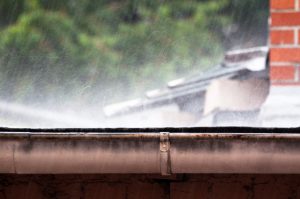How Often Should You Have Your Roof Inspected?
You don’t pay much attention to it, but the roof of your home is what protects you from the elements. If you want to make sure that your roof stays in good shape and remains leak free, then regular inspections need to be performed.
But how often are roof inspections needed?
The National Roofing Contractors Association recommends checking your roof at least twice of year—fall and spring when the weather tends to be more mild—to help spot any problems.
Not only does mild weather help make inspecting the roof easier, it also allows you to make sure that the roof will be prepared for the upcoming changes in temperature and potential seasonal weather hazards.

It’s also a good idea to inspect your roof after major weather events that involve high winds or hail. Even new roofs should be inspected after this type of situation because bad weather has the ability to damage or ruin a roof no matter what it’s age.
Although it isn’t always easy to complete this inspection as often as recommended, doing so will help prevent minor roof damage from leading to serious problems that can cause leaks and damage to the interior of the building.
Preventing minor problems from turning into major ones will also save you money in the future.
Should you hire someone to inspect your roof or should you do it yourself? There are advantages to each type of inspection, but it is important to remember that many roofing product replacement warranties will be voided or not honored if your roof hasn’t been inspected by a professional. Insurance companies tend to insist on professional roof inspections as well.
The best way to maintain your roof is to do both: inspect the roof yourself and have a professional roofer look at the roof as well.
If you don’t like heights or aren’t capable of climbing a ladder, call a roofing company to do the inspection for you. If tackling the job yourself, take a look at our handy roof inspection checklist.
DIY Roof Inspection Checklist
Every region of the country has different weather patterns and roofing problems, so it’s a good idea to know what to look for when it comes to your roof.
While a pair of binoculars can be used to check out the roof from the safety of your yard, the best way to inspect the roof yourself is by using a ladder and getting at the same height as your roof.

It isn’t necessary for you to physically climb up on your roof—and without the safety equipment that professionals use, it can be dangerous. Walking around on a roof that may be damaged is not only risky, it can also cause further damage.
Just move your ladder from spot to spot and work your way around your house to discover any potential problems.
Here is what you should look for:
- Broken or missing shingles
- Cracked or curling caulk or sealant
- Patches of moss and lichen
- Worn, peeling or cracked plastic rubber boots around pipes or other roof projections
- Cracked or rusted spots on metal flashings (Flashings are metal
roof pieces around dormers, chimneys, and vent pipes.) - Damaged or missing chimney cap
- Shingles that are blistering, cracking or buckling
- Loose, cracked or rusted gutters
- Crumbling or missing chimney mortar
- Tree branches or other large debris
If you have asphalt shingles—the most common roofing shingles in North America—make sure to also check your gutters for granules. These granules are what covers the surface of asphalt shingles and helps shield them from ultraviolet rays from the sun.
While some granule loss in normal over the life of your roof, a lot of granules can be a sign on shingle damage.
In places that can be awkward to get ladders, such as under eaves, overhangs and gutters, a pair of binoculars will come in handy to see any problems.
If your inspection reveals problems that can be solved easily—removing debris, nailing down loose shingles, unclogging gutters—then you can put your handyman skills to use and take care of it yourself.
More advanced DIY’ers may also be able to replace flashings and rubber seals themselves.
Hiring a Professional
If during your DIY inspection you notice cracked or rusted flashings or gutters, crumbling or missing chimney mortar, sunken spots in the roof, or several shingles that are buckling, cracking or missing, it’s best to schedule an appointment with a roofing company.

Excessive granules in your gutters, a damaged or missing chimney cap and loose caulking around dormers or skylights are also signs that you should call a professional.
Many roofing companies offer free or low-cost inspections. And unlike the average homeowner, an experienced professional will be able to spot problems that a homeowner may not even notice.
Roof Revivers specializes in saving our customers money by offering free 19-point inspection program. We carefully evaluate all aspects of your roof and identify any areas that may need repair or replacement. We take the time to thoroughly assess the condition of your roof and provide you with our recommendations.
A professional roofer will not only inspect your roof from the outside, but the inside as well. Your attic can show things that may be hidden from just inspecting the roof from the outside: holes, black mold and missing or damaged installation can all affect how well your roof functions.
Conclusion
It may seem like there is a lot to think about when it comes to inspecting your roof, but it will be worth it in the long run.
Schedule a roof inspection just like you would any other important maintenance task (like changing the oil in your car). It will end up saving you time and money in the future.
Contact Roof Revivers today for a free 19-point inspection of your roof or give us a call at 614-360-9703.






